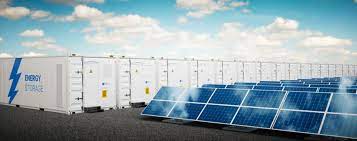DNV and Utility Dive recently released a report on the opportunity for non-lithium batteries considering the IRA using Zinc Bromine battery manufacturer Eos Energy Storage as a prime example. Read our takeaways here:
The 2022 Inflation Reduction Act was a long-awaited measure for energy storage advocates that provided investment tax credit (ITC) for stand-alone energy storage owners and investors. Tax credits differ in amount based on a variety of factors such as location, amount of domestic content and other requirements. Regardless, the IRA is creating space and opportunity for alternatives to lithium batteries that can potentially facilitate the transition to green energy. In line with the IRA’s goals, Octet’s technology contributes to the domestic supply chain, improves performance, and bolsters the inherent strengths of non-lithium technology (described below), particularly safe, sustainable and recycled Zinc-based batteries.
A Safer, Sustainable Alternative
The rapid growth of EV’s is driving the increased demand for lithium-ion batteries which in turn has caused concern over lithium’s scarcity and surging price. Particularly, between January 2020 and November 2022, the cost of lithium increased 12-fold, making it the opportune moment for an alternative: non-lithium batteries.
In addition to being more cost effective, non-lithium batteries also provide:
- Longer storage duration
Non-Lithium batteries excel in long-duration applications, offering discharges between 4 to 12 hours or longer, rendering them suitable for utility-scale stationary storage applications that support renewable energy integration.
- Safety
The risk of thermal runaway, catastrophic failures, and other flammable hazards is significantly reduced due to the aqueous and other inherently safe makeups of non-lithium batteries.
- Levelized Cost Storage
Certain non-lithium batteries exhibit long cycle life and relatively flat degradation curves created for a 20-year lifetime. This creates a significant advantage in the levelized cost of storage ensuring their cost-effectiveness throughout their operational lifespan.
Given their benefits and the aid of the IRA, the question is: can non-lithium companies and technologies scale up quickly enough?
The Race to Commercialization
The IRA can act as a catalyst for the non-lithium battery market in the race to commercialization, providing an opportunity for domestically manufactured technologies to compete with lithium-ion batteries amid shortages and rising prices.
However, the speed at which these companies reach commercialization is entirely dependent on the status of their R&D efforts, manufacturing line, and manufacturing process development.
Eos Energy Enterprises visualizes itself as a potential big player in the transition to clean energy. Eos is leveraging the significant opportunities created by the IRA and other laws and is now producing and delivering energy storage systems.
According to Chad Fitzgerald, VP of Strategic Partnerships at Eos, “the IRA legislation coupled with the Bipartisan Infrastructure Law together represent the most impactful industrial legislation in the US since the NAFTA.”
The Range of Options in the IRA
The IRA includes other non-lithium energy storage alternatives that each have their pros and cons.
Mechanical Storage
Pumped hydro, compressed air energy, and gravitational storage offer large capacities, high efficiency and a long-life cycle, but require specific geographic locations and high capital costs.
Thermal Storage Systems
Sensible heat storage and latent heat storage both provide relatively low-cost and efficient energy storage. However, sensible heat storage requires large volumes and latent heat storage is potentially more expensive and less efficient.
Other Battery Chemistries
Zinc-based, Sodium-ion and Flow Batteries are other chemistry options. Zinc-Based batteries have high energy density, a long cycle life, and are safer. Sodium-Ion batteries are an inexpensive alternative to lithium-ion but have lower energy density and a shorter cycle life. Flow Batteries are scalable, have a long cycle life and are highly dependable for grid-scale storage. However, they may be more expensive.
Alternative storage companies are gearing up to compete with lithium-ion batteries by focusing finalizing R&D in order to deploy more projects. The funding provided by the federal government under initiatives such as the DOE’s $125 million for small business clean energy R&D could help move them closer to the dance floor.
Challenges & Strategy
Companies like Eos face challenges stemming from the lack of familiarity with non-lithium batteries. They often must resort to resources such as third-party validation.
Eos partners with DNV to ensure their product’s credibility. Will Mao, CCO at Eos states, “It’s helpful having a robust third-party entity like DNV issuing very technical reports with exceptional amounts of data and validation.”
Another significant obstacle in the way of commercialization is gaining trust with insurance companies and banks. To tackle these issues, companies must educate other parties about their technology’s advantages financially, technically, and particularly in terms of supply chain.
In fact, part of what is fueling the enthusiasm for Eos’ technology is its manufacturing simplicity and scalability that it has demonstrated over the past year.
The IRA presents a tremendous opportunity for non-lithium battery manufacturers to seize, that will accelerate the energy transition and combat climate change. As global demand for clean energy grows, the development of innovative energy storage solutions becomes essential for the widespread adoption of renewable technologies.

